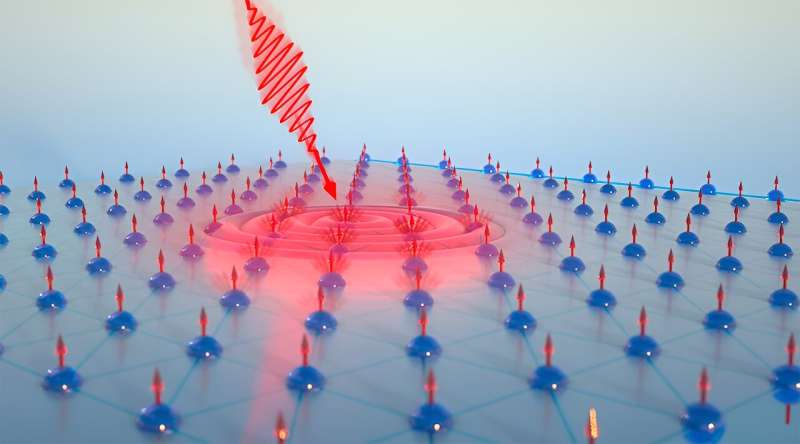Researchers discover new materials for optically controlled memory

Researchers in the Yang Lab at the UChicago Pritzker School of Molecular Engineering have made unprecedented progress in creating a new optical memory that can store and access computer data quickly and efficiently. Credit: Peter Allen, Pritzker School of Molecular Engineering, University of Chicago
Researchers at the University of Chicago Pritzker School of Molecular Engineering (PME) have made unprecedented progress in developing a new optical memory that can store and retrieve computer data quickly and efficiently. While studying complex materials made of manganese, bismuth and tellurium (MnBi2The4), the researchers noticed that the material’s magnetic properties changed quickly and easily in response to light. This means that a laser can be used to encode information into the magnetic field of MnBi2The4.
“This really highlights how basic science can enable new ways of thinking in direct engineering applications,” said Shuolong Yang, assistant professor of molecular engineering and senior author of the paper. youth. “We started with the motivation to understand the molecular details of this material and ended up realizing that it had previously undiscovered properties that made it very useful.”
On paper printed on Advances in ScienceYang and co-workers showed how the electrons in MnBi2The4 compete between two opposing states—a topological state that works for encoding quantum information and an insensitive state that works for optical storage.
Solving a topological problem
In the past, MnBi2The4 has been studied for its promise as a magnetic topological insulator (MTI), a material that behaves like an insulator on its inside but conducts electricity on its outside surfaces. For an ideal MTI in a 2D boundary, a quantum phenomenon occurs where electricity flows in a two-dimensional stream near its edges. These so-called “electron freeways” have the potential to contain and transport quantum data.
Although scientists have predicted that MnBi2The4 should be able to receive such a freeway electron, the material has been difficult to work with tests.
“Our first goal was to understand why it has been so difficult to find these topological properties in MnBi2The4,” said Yang. “Why is the predicted physics missing?”
To answer that question, Yang’s team turned to advanced spectroscopy techniques that allowed them to visualize the behavior of the electrons inside MnBi.2The4 in real time on a fast time scale. They used time- and angle-resolved photoemission spectroscopy developed in Yang’s lab, and collaborated with Xiao-Xiao Zhang’s group at the University of Florida to make time-resolved measurements of the magneto-optical Kerr effect (MOKE), allowing observe the magnetic field. .
“This combination of methods gave us direct information about not only how the electrons were moving, but how their properties are coupled with light,” explained Yang.
Two opposing countries
When the researchers analyzed their spectroscopy results, it became clear why MnBi2The4 it did not work as a good topological property. There was a quasi-2D electronic state, which competed with the topological state for electrons.
“There is a completely different type of surface electrons that replace the original topological electrons,” Yang said. “But it turns out that this quasi-2D state actually has different, very useful properties.”
The second electronic state consisted of a tight coupling between the magnet and the external photons of light—impractical for sensitive quantum data but the exact requirements for efficient memory.
To further explore this potential application of MnBi2The4Yang’s team is now planning experiments in which they use lasers to control the material’s properties. They believe that the optical memory uses MnBi2The4 they can be orders of magnitude more efficient than today’s electronic memory devices.
Yang also showed that a better understanding of the balance between the two electronic states on MnBi2The4 it can enhance its ability to act as MTI and be useful in quantum data storage.
“Maybe we can learn to measure the balance between the original, predicted state and this new quasi-2D electronic state,” he said. “This is made possible by controlling our levels of integration.”
Additional information:
Khanh Duy Nguyen et al, Differential field and bulk electric field by their strength in a natural magnetic topological insulator, Advances in Science (2024). DOI: 10.1126/sciadv.adn5696
Offered by the University of Chicago
Excerpt: Researchers discover new materials for optically controlled memory (2024, August 9) Retrieved on August 11, 2024 from https://phys.org/news/2024-08-material-optically-magnetic-memory .html
This document is subject to copyright. Except for any legitimate activity for the purpose of private study or research, no part may be reproduced without written permission. Content is provided for informational purposes only.
#Researchers #discover #materials #optically #controlled #memory